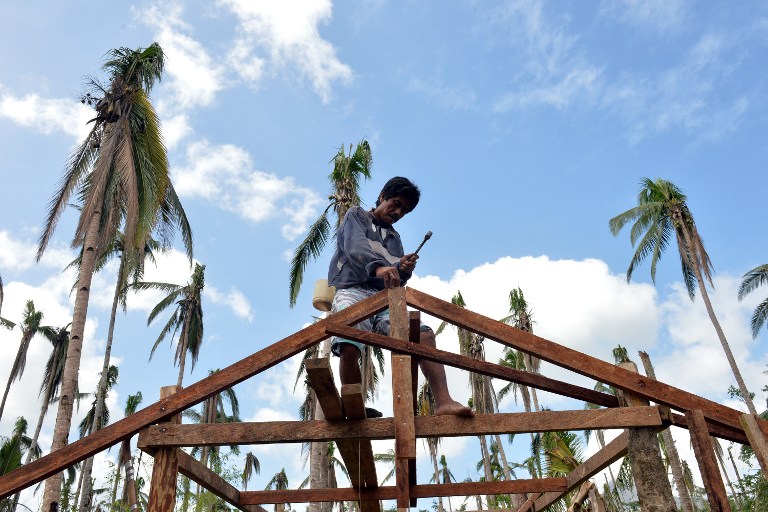IMF, S&P raise PH growth forecasts

A resident-survivor of Typhoon Haiyan builds his house next to destroyed coconut trees at a village in Jaro town, in Leyte province, on Feb. 17, 2014. The International Monetary Fund has raised its growth forecast for the Philippines for this year, supported by higher demand due to reconstruction-related efforts in the Visayas. AFP PHOTO/TED ALJIBE
MANILA, Philippines—The International Monetary Fund (IMF) has raised its growth forecast for the Philippines for this year, supported by higher demand due to reconstruction-related efforts in Visayas.
IMF representatives also put forward a set of reforms, which range from the rationalization of tax perks to a more open policy for the entry of foreign investors, that would allow the Philippine economy to perform at its “full potential.”
“While the envisaged growth path is faster than what was achieved during the previous decades, realizing the Philippines’ full potential for rapid, sustained and inclusive growth calls for further reducing bottlenecks to investment and formal sector employment,” the IMF said.
The Philippines is seen growing by 6.5 percent this year, better than the 6.25 percent that the Fund thinks is the country’s current potential for expansion. The forecast is also better than the previous projection of 6.3 percent, which was issued on Jan. 22.
Last year, the Philippine economy grew by 7.2 percent—the fastest for any major Southeast Asian economy.
In a separate report on Wednesday, Standard & Poor’s also raised its growth projection for the Philippines to 6.6 percent for 2014. “Growth in the Tiger economies will likely pick up this year, in step with global trade improvements driven by the US and Europe,” S&P said.
IMF officials concluded their annual Article IV consultation review mission to the Philippines this week. At a press conference on Wednesday, IMF Philippines mission chief Rachel Van Elkan said the effects of the US Federal Reserve’s tighter policy settings, which are expected to lead to higher interest rates globally, were already incorporated in the forecast for the country.
“The (Philippines) is well-positioned to absorb a gradual tightening of US financial conditions to implement timely, measured action on the domestic policy front,” Van Elkan said.
“With potential growth estimated at 6.25 percent, the positive output gap is expected to widen slightly in 2014 as the fiscal stimulus from reconstruction activities related to Yolanda further supports growth,” she added.
Van Elkan said the IMF would support further reforms that would bolster the strength of the Philippine economy. Among these were the rationalization of fiscal incentives, which would help the government expand its tax base.
“Mobilizing the additional revenue needed to meet the authorities’ goal of achieving 5 percent of GDP infrastructure spending by 2016, while remaining within the 2 percent of GDP ceiling, should rely primarily on tax base broadening,” Van Elkan said.
Amendments to laws that restrict the entry of foreign investors in the country, such as the Cabotage law and the negative list for foreign investments, would also support job generation in line with the government’s goal of inclusive growth.
